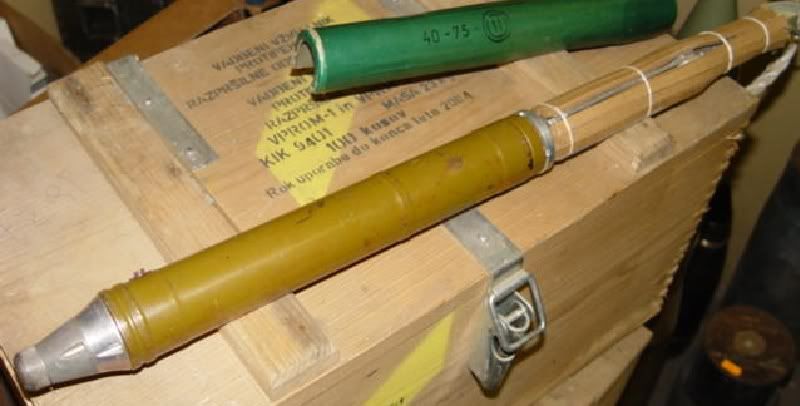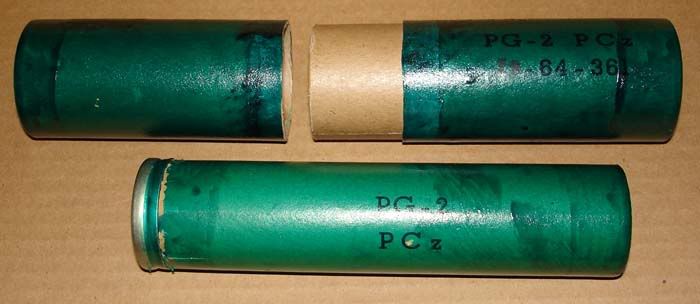RE
Actually, depending on the various nebulous definitions of "rocket" floating around it could go either way. Better to argue that it is not a missile! That being said, long ago the Soviets / Russians officially designated both weapons as Shoulder Fired (Ruchnoy), Anti-Tank (Protivitankovaya), Rocket Launchers (Granatomet). The West just sort of took for granted that the phonetic "R.P.G." from the Soviet designation should mean Rocket Propelled Grenade. Since both are considered "Rocket Launchers" by "them" but not by everyone else, much confusion has reigned since then. However, the commonality - besides the descriptor - is that both a PG-2 round of munition and a PG-7 round of munition have to use a screw-on propelling charge to leave the launcher and the ejection gases are "immediately" vectored out of the rear of the launch tube. With that as the litmus test, both a PG-2 round and PG-7 round fit nicely into "recoilless projectile" explanation mentioned above.
The PG-7P ( ПГ-7П) series propelling charge for an "RPG-7" round and the DRP ( ДРП) series propelling charge for an "RPG-2" round both work the same way; they both "launch" their respective rounds from the launch tube.
However, that is where the similarities end. The DRP uses a loose black-powder (highly refined of course, but black powder nonetheless) as a propellant. The propellant is separated by five (or six) cardboard, Bakelite, rubber, ceramic or aluminum disks or spacers - not counting the threaded cap-well and base of course. (The Chinese made an enhanced DRP clone for their Type 56-II round that was approximately of an inch longer than a standard DRP charge - it had six spacers).

The PG-7P series uses an NBL-based propellant in strip form (heavily impregnated paper) laid along the long axis of an aluminum fin assembly which contains the four inertia-activated stabilizing fins and a slow rotation "fan" at the extreme rear of the assembly. The PG-2 stabilizing fins are organic to the round itself and not part of the propelling charge - unlike a PG-7 munition.
NBL info here: http://www.arsenal-bg.com/defense_police/powders_table.htm
NBL in strip form:

(Stabilizing fins and slow roll "fan". The paper sleeve covering the NBL strips burns away as the propellant burns (before the round leaves the launch tube)).
Most PG-7 rounds also have an organic "booster charge" (PG-7D) that further propels the round down range once the PG-7P series propelling charge is exhausted (approx 9-25 meters depending on the round). These gases are vented out of a series of six nozzles just below the rear fuze assembly base (behind the rear ogive).

While all PG-7 compatible munitions use a propelling charge, not all of them have the booster charge and vent nozzles. Any OG-7 series (or clone) Anti-Personnel round does not need to use this booster charge because there is no over-caliber warhead involved in the flight-path / trajectory equation (any OG-7 series or clone are 40mm in diameter; meaning most of the round fits in the tube.)
OG-7:

Hope this helped and did not further cloud this issue.
Semper Fidelis
Gunner
Thanks mate. I only used the "rocket" term as an expression for the overall item, instead of "projectile". I also have a the PG-7 round in my collection and i'm used to call both of 'em "rockets". So the PG-7 is a true rocket and the PG-2 is a recoilless projectile.
Every day brings a learning opportunity.
Actually, depending on the various nebulous definitions of "rocket" floating around it could go either way. Better to argue that it is not a missile! That being said, long ago the Soviets / Russians officially designated both weapons as Shoulder Fired (Ruchnoy), Anti-Tank (Protivitankovaya), Rocket Launchers (Granatomet). The West just sort of took for granted that the phonetic "R.P.G." from the Soviet designation should mean Rocket Propelled Grenade. Since both are considered "Rocket Launchers" by "them" but not by everyone else, much confusion has reigned since then. However, the commonality - besides the descriptor - is that both a PG-2 round of munition and a PG-7 round of munition have to use a screw-on propelling charge to leave the launcher and the ejection gases are "immediately" vectored out of the rear of the launch tube. With that as the litmus test, both a PG-2 round and PG-7 round fit nicely into "recoilless projectile" explanation mentioned above.
The PG-7P ( ПГ-7П) series propelling charge for an "RPG-7" round and the DRP ( ДРП) series propelling charge for an "RPG-2" round both work the same way; they both "launch" their respective rounds from the launch tube.
However, that is where the similarities end. The DRP uses a loose black-powder (highly refined of course, but black powder nonetheless) as a propellant. The propellant is separated by five (or six) cardboard, Bakelite, rubber, ceramic or aluminum disks or spacers - not counting the threaded cap-well and base of course. (The Chinese made an enhanced DRP clone for their Type 56-II round that was approximately of an inch longer than a standard DRP charge - it had six spacers).

The PG-7P series uses an NBL-based propellant in strip form (heavily impregnated paper) laid along the long axis of an aluminum fin assembly which contains the four inertia-activated stabilizing fins and a slow rotation "fan" at the extreme rear of the assembly. The PG-2 stabilizing fins are organic to the round itself and not part of the propelling charge - unlike a PG-7 munition.
NBL info here: http://www.arsenal-bg.com/defense_police/powders_table.htm
NBL in strip form:

(Stabilizing fins and slow roll "fan". The paper sleeve covering the NBL strips burns away as the propellant burns (before the round leaves the launch tube)).
Most PG-7 rounds also have an organic "booster charge" (PG-7D) that further propels the round down range once the PG-7P series propelling charge is exhausted (approx 9-25 meters depending on the round). These gases are vented out of a series of six nozzles just below the rear fuze assembly base (behind the rear ogive).

While all PG-7 compatible munitions use a propelling charge, not all of them have the booster charge and vent nozzles. Any OG-7 series (or clone) Anti-Personnel round does not need to use this booster charge because there is no over-caliber warhead involved in the flight-path / trajectory equation (any OG-7 series or clone are 40mm in diameter; meaning most of the round fits in the tube.)
OG-7:

Hope this helped and did not further cloud this issue.
Semper Fidelis
Gunner
Last edited:



